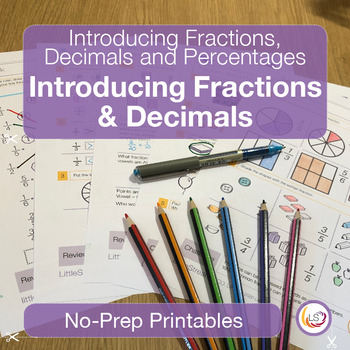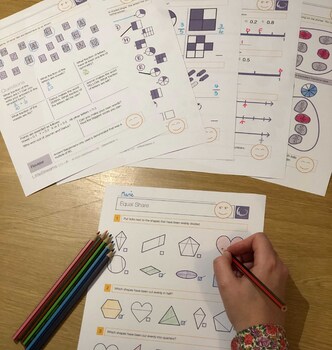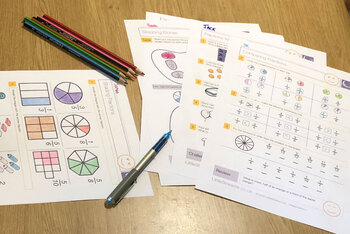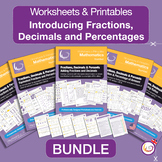Introducing Fractions and Decimals
- Zip
Also included in
- UPDATED April 2024: To include three differentiated student booklets for each pack, making it easier to print and go. This extensive bundle includes 5 packs on fractions, decimals, percentages and ratios. Each pack contains 10 individual worksheets all differentiated 3 ways. Giving a total of 50 uniPrice $22.50Original Price $27.50Save $5.00
Description
UPDATED April 2024: To include three differentiated student booklets, making it easier to print and go.
This pack is filled with worksheets designed to introduce students to fractions and understanding the relationship between different fractions. It also covers decimals, asking students to put decimals in order of size. Each worksheet is differentiated 3 ways. There are two files: the worksheet files and the teachers file that includes the solutions.
It contains the following worksheets:
Worksheet 1 Equal Share
Worksheet 2 Identifying Fractions
Worksheet 3 Shading Fractions
Worksheet 4 Word Link
Worksheet 5 Letters
Worksheet 6 Fraction and Decimal Number Lines
Worksheet 7 Word Problems
Worksheet 8 Comparing Fractions
Worksheet 9 Comparing Decimals
Worksheet 10 Stepping Stones
The first worksheet takes a look at what is meant by breaking shapes into equal sizes, and builds understanding of what fractions are. The second worksheet is about stating the fraction of the shape or group of objects that are shaded. The first differentiation gives clues for the first few questions, level two just gives an example, and level three asks students to simplify where possible. The third worksheet is a continuation of the second, this time asking students to shade the given fraction on the shape or group of objects.
The fourth worksheet has students connect a written fraction to its shaded shape form. When these lines are connected, a name of a famous mathematician is discovered. For the level 1 differentiation, some answers are given to get them started. The fifth worksheet looks at letters and asks students to find what fraction of certain letters are vowels or are made up of words. It also consists of some simple adding decimals.
Worksheet six consists of number lines. Students are asked to put fractions and decimals in the correct places on the number lines. They are also asked to identify where 1 is on the number line, given the position of a given fraction. Differentiations 2 and 3 explore top heavy fractions.
Worksheet seven asks simple fraction word problems. Worksheet eight builds on this by comparing the sizes of fractions directly. Differentiation 1 includes images of fractions as well as the written form to help students visualise the solution. The ninth worksheet is a continuation of worksheet eight, but covering decimals. The tenth and final worksheet also asks students to compare fractions to find the largest, but in a more fun way. The worksheet consists of pictures of stones in a pond, and students must choose the largest fraction in each column to step on to get across the pond.
This Worksheet/Printables Pack is available as an INTRO BUNDLE with 5 other packs for just $15!
Please click here to visit our website for more information about LittleStreams






